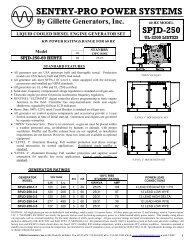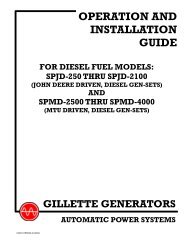PORTABLE Srvm3-20120822 - Gillette Generators
PORTABLE Srvm3-20120822 - Gillette Generators
PORTABLE Srvm3-20120822 - Gillette Generators
Create successful ePaper yourself
Turn your PDF publications into a flip-book with our unique Google optimized e-Paper software.
Scheduled maintenance is "preventative maintenance".<br />
Major repairs can be avoided by correcting problems when<br />
they are small. Always look for signs of potential trouble,<br />
such as loose electrical connections, loose hardware or<br />
loose mechanical connections. Loose screws and bolts,<br />
bad fuel connections. Always test the GFCI receptacles (if<br />
your gen-set has them) before each use.<br />
SCHEDULED MAINTENANCE<br />
When running the generator set, note any unusual noises<br />
or unusual smells. Always follow all safety precautions<br />
listed in the front of this manual. Refer to table on this<br />
page for scheduled maintenance of the generator.<br />
Perform each function at the indicated time interval. Refer<br />
to engine manual for its individual service requirements.<br />
ITEM OF INSPECTION AND SERVICE<br />
Operate in only dry, well ventilated areas.<br />
Inspect for broken or dirty receptacles.<br />
Remove inspection cover and view windings<br />
for burned or dirty windings.<br />
Tighten all stator thru-bolts, rotor thru-bolts.<br />
Inspect wiring for frayed or damaged insulation.<br />
Tighten all screws on all receptacles. Inspect connections to<br />
capacitor. They must be tight.<br />
Remove all ground wires, clean wire terminals and ground<br />
location. Re-assemble ground wire.<br />
BEFORE<br />
EACH START<br />
x<br />
x<br />
EVERY 50<br />
HOURS<br />
x<br />
EVERY 200<br />
HOURS<br />
x<br />
x<br />
x<br />
GENERATOR REPAIR PROCEDURES<br />
GENERAL<br />
When repairing the generator, always consider the<br />
simplest possible causes first. Narrow the problem down<br />
to a specific functional system. For a generator to work<br />
properly, all internal and external parts must be clean. All<br />
electrical connections must be tight. If the generator<br />
produces no electrical power, check the following possible<br />
causes in the exact sequence of (10) repair steps,<br />
beginning with the most frequent problem, before the genset<br />
is dis-assembled.<br />
STEP 1. Engine Speed: Improper low engine speed<br />
setting is very common and results in being the main<br />
problem in a no voltage condition. This should be the first<br />
item to check. Determine the engine speed at no load<br />
applied to generator with a tachometer or other qualified<br />
speed indicator. The engine must be running at 3750<br />
RPM (± 60 RPM) or in the case of a special 50 cycle<br />
winding, the running speed must be at 3150 RPM (± 50<br />
RPM) for proper voltage output.<br />
The brushless "Power-Assist" winding is designed to<br />
produce no voltage output if engine speed is reduced 15%<br />
or more (3100 RPM at normal speed of 3750 RPM 60<br />
hertz or 2600 RPM at normal speed of 3150 RPM 50<br />
hertz) below required speed. This design feature<br />
eliminates the problem of low voltage output at low speeds<br />
which is a common problem with competitor's generators<br />
and which may result in damage to the plugged-in electric<br />
load.<br />
Proper speed setting can also be identified by no load<br />
voltage output of 122 - 125 volts or no load frequency<br />
output of 62 hertz. If speed setting is proper and not the<br />
cause of no voltage output, proceed to the next repair<br />
step, #2.<br />
STEP 2. Open Circuit Breaker: The A-C mainline<br />
circuit breaker acts to protect the main power winding. It<br />
will trip open immediately upon short circuit and trip open<br />
within 30 seconds at approximately 15% overload. To<br />
restore A-C output, close circuit breaker. Reduce the<br />
amount of electric load if breaker continues to trip open. If<br />
generator has no electric load applied and breaker<br />
continues to trip, replace defective breaker.<br />
If you are operating the gen-set when ambient<br />
temperatures are higher than 105 F, the thermal breakers<br />
will automatically trip as a normal function. Do not operate<br />
generator in these hot conditions. If the circuit breaker is<br />
determined not to be the cause, proceed to the next repair<br />
step, #3.<br />
STEP 3. Open or Shorted Capacitor:<br />
Our voltage regulating capacitors are of one common size,<br />
50 mfd at 440 volts. They can be used in any size<br />
generator for complete interchangeability. If this capacitor<br />
is open or shorted near to no voltage output will result.<br />
Always handle or test the capacitor when the engine is<br />
stopped. Extremely high voltage is present at the<br />
capacitor terminals while generator is in use and these<br />
terminals should not be touched as a potential electric<br />
shock condition exists. Also, when engine is stopped, the<br />
capacitor will still contain high voltage. Use extreme<br />
caution when handling capacitors. A potential shock<br />
condition still exists if safe handling procedures are not<br />
used. Always discharge the capacitor before handling by<br />
placing a conductor, such as an insulated handle<br />
screwdriver, across the capacitor terminals while holding<br />
on to insulated handle only. This will short out the voltage<br />
stored in capacitor, thus discharging the capacitor. A loud<br />
audible noise will result when capacitor is discharged.<br />
(5)







